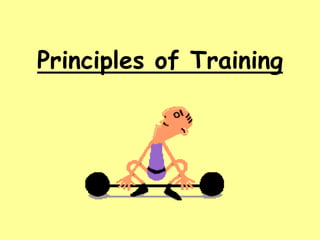Principles of training
•Transferir como PPTX, PDF•
16 gostaram•29,305 visualizações
Denunciar
Compartilhar
Denunciar
Compartilhar

Recomendados
Mais conteúdo relacionado
Mais procurados
Mais procurados (20)
Destaque
Destaque (20)
Training and Development - Principles of Human Resource Management

Training and Development - Principles of Human Resource Management
Semelhante a Principles of training
Semelhante a Principles of training (20)
introductiontofitnesstraining-140402032353-phpapp01 (1).pptx

introductiontofitnesstraining-140402032353-phpapp01 (1).pptx
Mais de lsecker
Mais de lsecker (6)
Último
https://app.box.com/s/x7vf0j7xaxl2hlczxm3ny497y4yto33i80 ĐỀ THI THỬ TUYỂN SINH TIẾNG ANH VÀO 10 SỞ GD – ĐT THÀNH PHỐ HỒ CHÍ MINH NĂ...

80 ĐỀ THI THỬ TUYỂN SINH TIẾNG ANH VÀO 10 SỞ GD – ĐT THÀNH PHỐ HỒ CHÍ MINH NĂ...Nguyen Thanh Tu Collection
Último (20)
Beyond_Borders_Understanding_Anime_and_Manga_Fandom_A_Comprehensive_Audience_...

Beyond_Borders_Understanding_Anime_and_Manga_Fandom_A_Comprehensive_Audience_...
Unit 3 Emotional Intelligence and Spiritual Intelligence.pdf

Unit 3 Emotional Intelligence and Spiritual Intelligence.pdf
Interdisciplinary_Insights_Data_Collection_Methods.pptx

Interdisciplinary_Insights_Data_Collection_Methods.pptx
Kodo Millet PPT made by Ghanshyam bairwa college of Agriculture kumher bhara...

Kodo Millet PPT made by Ghanshyam bairwa college of Agriculture kumher bhara...
ICT Role in 21st Century Education & its Challenges.pptx

ICT Role in 21st Century Education & its Challenges.pptx
Sensory_Experience_and_Emotional_Resonance_in_Gabriel_Okaras_The_Piano_and_Th...

Sensory_Experience_and_Emotional_Resonance_in_Gabriel_Okaras_The_Piano_and_Th...
Basic Civil Engineering first year Notes- Chapter 4 Building.pptx

Basic Civil Engineering first year Notes- Chapter 4 Building.pptx
Food safety_Challenges food safety laboratories_.pdf

Food safety_Challenges food safety laboratories_.pdf
80 ĐỀ THI THỬ TUYỂN SINH TIẾNG ANH VÀO 10 SỞ GD – ĐT THÀNH PHỐ HỒ CHÍ MINH NĂ...

80 ĐỀ THI THỬ TUYỂN SINH TIẾNG ANH VÀO 10 SỞ GD – ĐT THÀNH PHỐ HỒ CHÍ MINH NĂ...
UGC NET Paper 1 Mathematical Reasoning & Aptitude.pdf

UGC NET Paper 1 Mathematical Reasoning & Aptitude.pdf
NO1 Top Black Magic Specialist In Lahore Black magic In Pakistan Kala Ilam Ex...

NO1 Top Black Magic Specialist In Lahore Black magic In Pakistan Kala Ilam Ex...
Principles of training
- 2. Learning Objectives... • Define and explain the principles of training. • Apply the principles of training to examples from a PEP.
- 3. Starter... • Complete the match it work sheet for definitions. 1. Individual Needs 2. Specificity 3. Progressive Overload 4. Rest 5. Recovery 6. FITT 7. Reversibility
- 4. 1. Individual Needs 7. Reversibility 2. Specificity 6. FITT Principles of Training 3. Progressive 5. Recovery overload 4. Rest
- 5. Individual Needs • ‘Matching training to the requirements of an individual.’ • 1st time marathon runners Elite • How would their individual needs in a PEP be different? • Individual needs – fitness levels, sport, SMART goals, methods of training, facilities.
- 6. SPECIFICITY • Matching training to the requirements of an activity. • E.g, a shot putter would train differently to a runner. • There is a need for List 3 more examples of specific training within a specificity. sport too… •A sprinter would train on speed • A goal keeper would train differently to an outfield •A long distance runner on CV player.
- 7. PROGRESSIVE OVERLOAD You won’t be able to lift these weights straight • Increasing the amount of overload gradually away!!! so that fitness gains occur, but without the potential for injury. • Start gently and build up gradually. • If you exercise at a constant level, your fitness will stay at that same level. • Body adjusts to the PLATEAUING = progress halts – demands placed upon it. takes time to move on to next level.
- 8. • Overload means training harder than you normally do. • Working at a higher range of intensity. • Training in the TARGET ZONE • E.g. for strength training – lifting a weight at 60-80% of maximum effort. • CV 60 – 80% Max HR. • Usually apply overload every 2 weeks
- 9. OVERLOAD • Fitness can only be improved by doing more than usual. • Making the body work harder than normal in order to improve. • To OVERLOAD you need to apply the FITT principle!
- 10. • F = Frequency. How often you need to train to improve. • I = Intensity. How hard you train. • T = Time How long each training session lasts. • T = Type What sort of training you do.
- 11. REVERSIBILITY If regular training stops, any adaption that takes place as a consequence of training will be reversed. • This is why you need to train 2/3 times a week or the effects of training will be lost. • Use it or lose it!
- 12. Rest and Recovery • Rest = The time given to recovery. • Recovery = The time required to repair damage to the body caused by training or competition. • PEP – someone training 5X a week would probably train on 3 days, take day off to recover and allow adaption to take place. Train for the next 2 days, rest on the 7th day.
- 13. TASK: • Apply your knowledge and understanding by creating a guide for young athletes to use. (See work sheet). • Give specific examples of how to apply each of the principles of training in order to improve fitness for a chosen sport.